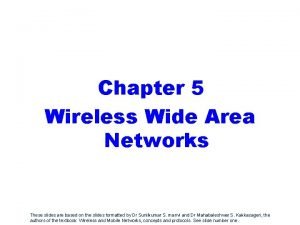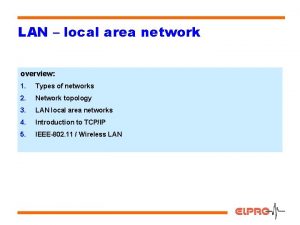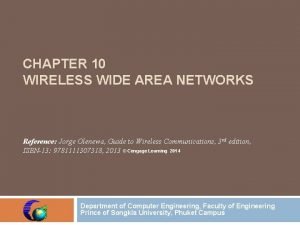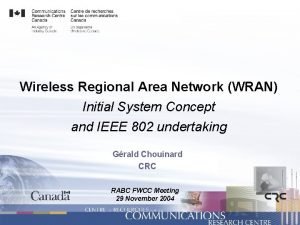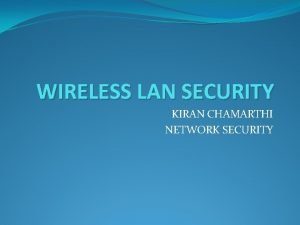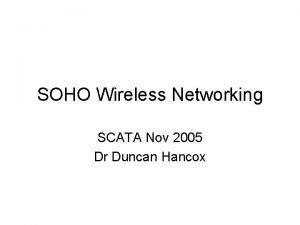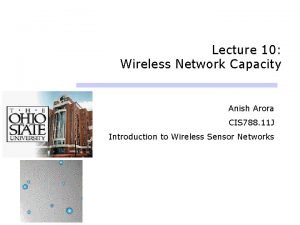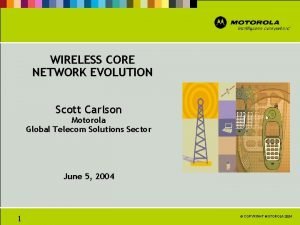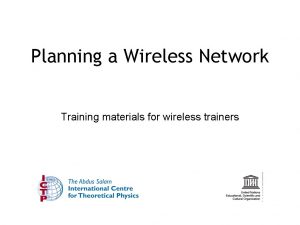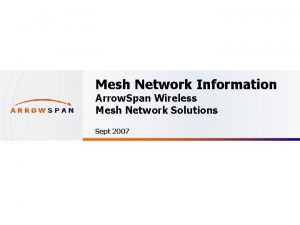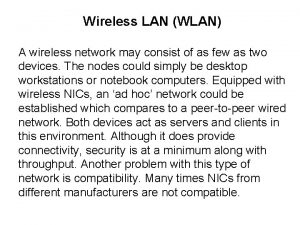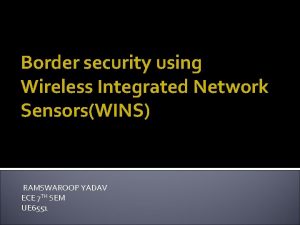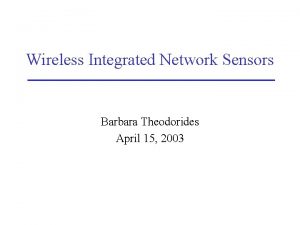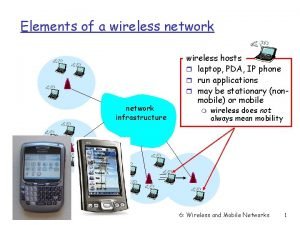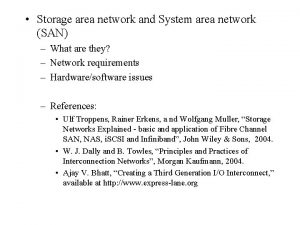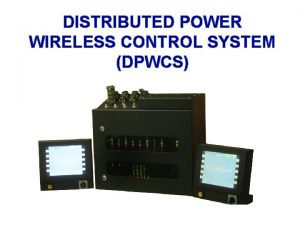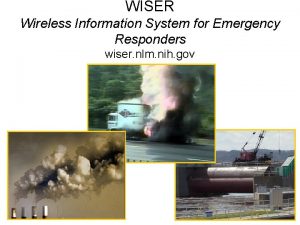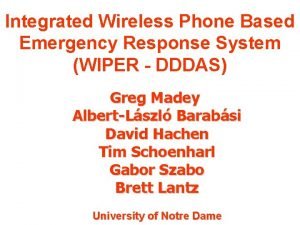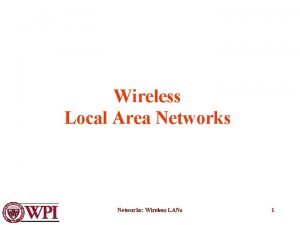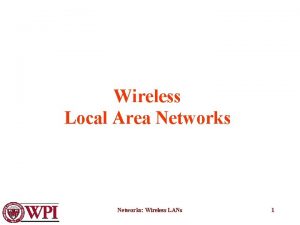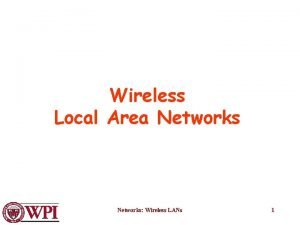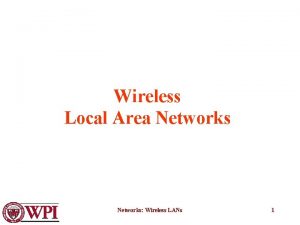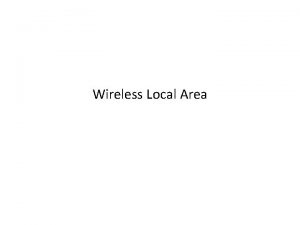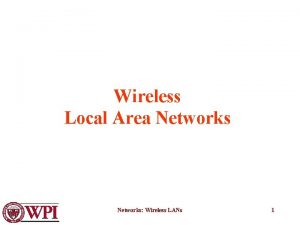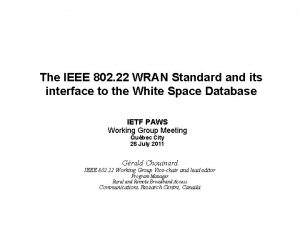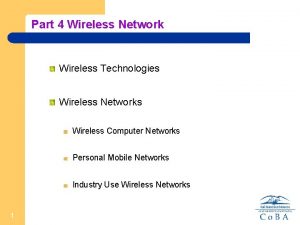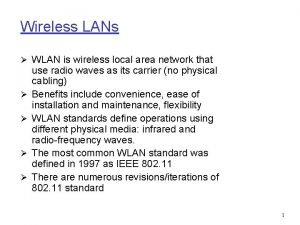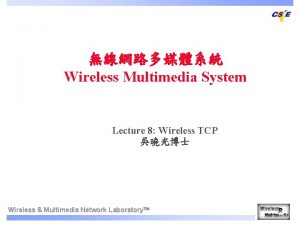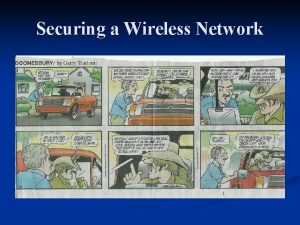Wireless Regional Area Network WRAN Initial System Concept




























- Slides: 28

Wireless Regional Area Network (WRAN) Initial System Concept and IEEE 802 undertaking Gérald Chouinard CRC RABC FWCC Meeting 29 November 2004

CRC RRBA Program: www. crc. ca/broadband

- Cable-modem / ADSL - Wi. Fi hot-spots in ISM bands - Higher power, lower frequency broadband access system Rural Broadband: MAC Long excess delays 20 km 64 -QAM 30 km 40 km 16 -QAM QPSK PHY Adaptive modulation

Household reach by technologies (“last mile”)

Frequency of operation: Propagation considerations

Frequency of operation: User terminal and base station considerations

Optimum frequency range for large area Non-Line-of-sight Broadband Access

Existing RF spectrum usage Main markets

WRAN: Wireless Regional Area Network • fits with the FCC definition of “Fixed/Access” category of operation given in the NPRM 04186 on the use of TV band by license-exempt devices – aimed at bringing broadband access in rural and remote areas – takes advantage of better propagation characteristics at VHF and low-UHF – Takes advantage of unused TV channels that exist in these sparsely populated areas

WRAN System Concept • Main constraint is to avoid interference to the incumbent services such as TV broadcasting (NTSC and DTV), wireless microphones, and Public Safety systems in channels 14 to 20 in certain markets • Use of etiquette is assumed for accommodation of as many LE operators as possible

WRAN Base Stations • Operation of WRAN is based on Fixed Wireless Access provided by professionally installed base stations that will control the RF characteristics of the user terminals • The base stations will be: – Planned according to the available TV channels in the area (channels for which the coverage area will be outside the Grade-B contours of existing and expected TV stations – Operated by a legal entity with which incumbent systems could resolve potential interference problems

Possible modulation characteristics • Adaptive modulation: typical spectrum capacity: 3 bit/(sec*Hz) (e. g. , 64 -QAM with ¾ code rate) • The full 6 MHz channel is expected to be used to provide some 18 Mbit/sec shared forward capacity • OFDM type modulation to counter increased multipath due to less directional antennas at VHF and low UHF (e. g. , 1000 carriers to cover a range of 0. 16 μsec to up to 33 μsec) (8000 carriers if on-channel repeaters are needed? ) • OFDMA on the return link to allow scaling of the user terminal transmit power to the transmitted data rate

WRAN User Terminal • The user terminals: – Will be available as ‘commodity’ item from any electronic stores – Will not need to be licensed nor registered – Will include interference sensing capabilities – Could be installed by simply connecting it to: • A VHF and/or UHF antenna (log-periodic type for wide frequency range or Yagi for a narrow scanning range) • a computer (through an Ethernet connector or through an integrated Wi-Fi Access Point) • a power outlet.

CPE Mock-up (RF based on low-cost UHF-TV tuners RF Input Ethernet to computer Power Supply RF Output

WRAN User registration • As part of the registration, the user will need to specify the geographic coordinates of the terminal through its civic address or GPS geolocation • The RF characteristics of the terminal will be under total control of the base station to alleviate any interference and control it at the network level. • The base station will initiate sensing of TV and other RF signals at the user terminals, collect the information centrally and take action at the system level to avoid interference (e. g. , change the frequency of a sector)

WRAN Forward Link QPSK for edge of coverage

WRAN Return Link Videoconferencing

WRAN System Capacity and Coverage

Range of population density covered Satellite ADSL, Cable, ISM and UNII Wireless and Optical Fiber WRAN 4 W Base Station WRAN 4 W CPE

IEEE Standards RAN “Regional Area Network” IEEE 802. 22 40 km w 5 o c 2 siencd e s μ W μ 2. 2 tion ) rp efix 5 o 2 s 0. ab lic pr th Cyc a ( p i 0. 8 lt Mu 18 Mbps BW= 6, 7, 8 MHz 54 - 862 MHz

IEEE 802. 18 Comments on the FCC NPRM 04 -186 (License-exempt Operation in the TV Broadcast Bands) • Personal/Portable category of LE devices (100 m. W EIRP): – “The members of IEEE 802. 18, who represent all the stakeholders in this proceeding, have worked diligently and collaboratively on the personal/portable class of devices. If the Commission elects to move forward to draft Rules for personal/portable devices, it should ensure that they do not operate co-channel within the Grade B contour of a licensed television station and comply with the same adjacent channel D/U ratios as proposed in the NPRM for fixed/access devices. ”

IEEE 802. 18 Comments on the FCC NPRM 04 -186 (License-exempt Operation in the TV Broadcast Bands) • Fixed/Access category of LE devices: – “… appears to be well suited for larger regional area networks (RAN) based on point-to-multipoint operation using higher power to extend the reach - especially in rural and remote areas. ” – “Currently, IEEE 802 is proposing 1 W maximum conducted power, 4 W maximum EIRP for the Fixed/Access category of devices (base stations and CPEs), but we believe that in the future, subject to further studies, it may be possible for the Commission to allow higher powers for the Fixed/Access base station. – “Fixed/Access base stations should be professionally installed and registered. ”

IEEE 802. 18 Comments on the FCC NPRM 04 -186 (License-exempt Operation in the TV Broadcast Bands) • Fixed/Access category of LE devices (cont’d) : – Master/slave relationship between the base station and the CPE’s (all RF characteristics of CPE’s controlled from the base station) – Use of Transmit Power Control (TPC) – Use of cognitive radios: distributed spectrum sensing reported to the base station • Sensing thresholds: – DTV threshold: -116 d. Bm (total DTV power in the 6 MHz channel) – Analog TV threshold: -94 d. Bm (measured at peak of sync of the picture carrier) – Wireless microphone threshold: -107 d. Bm (measured in 200 k. Hz bandwidth)

IEEE 802. 18 Comments on the FCC NPRM 04 -186 (License-exempt Operation in the TV Broadcast Bands) • Fixed/Access category of LE devices (cont’d) : – CPEs would normally be installed by the end user who would provide the physical location of the installation. The antenna system (TX and RX) would need to include an omni-directional sensing antenna. – Verification that the CPE antennae are permanently installed outdoors on a fixed structure and properly aligned should be required. – For wireless microphone protection, the first line of defence will be based on the distributed sensing capability of the CPE’s, if it is not sufficient, the use of a beacon system may be the most practical and reliable method of preventing interference.

IEEE 802. 22 Project Authorization Request (PAR) • Wireless Regional Area Networks (WRAN) • 802. 22 is to define: – MAC: Cognitive Wireless RAN Medium Access Control – PHY: Physical Layer specifications – Policies and procedures for operation in the TV Bands • “This standard specifies the air interface, including the medium access control layer (MAC) and physical layer (PHY), of fixed point-to-multipoint wireless regional area networks operating in the VHF/UHF TV broadcast bands between 54 MHz and 862 MHz. ”

IEEE 802. 22 Project Authorization Request (PAR) • Purpose: “This standard is intended to enable deployment of interoperable 802 multivendor wireless regional area network products, to facilitate competition in broadband access by providing alternatives to wireline broadband access and extending the deployability of such systems into diverse geographic areas, including sparsely populated rural areas, while preventing harmful interference to incumbent licensed services in the TV broadcast bands. ” • Reason: “There is a large, untapped market for broadband wireless access in rural and other unserved/underserved areas where wired infrastructure cannot be economically deployed. Products based on this standard will be able to serve those markets, taking advantage of the favorable propagation characteristics in the VHF and low UHF TV bands and increase the efficiency of spectrum utilization in spectrum currently allocated to, but unused by, the TV broadcast service. ”

Conclusions • There is a need to bring Broadband Access to rural areas – The best means is through wireless systems – The best frequency range is the low-UHF range (below 1 GHz) • There is an important thrust by the FCC to allow the use of LE devices in fallow TV broadcast spectrum – IEEE 802. 18 identified two types of uses: • Portable/personal use (e. g. , Wi-Fi, Wi-Max type): still unresolved • Fixed/access for Wireless Regional Area Networks (WRAN): the ‘sandbox’ has been defined • IEEE has initiated the development of a standard for WRAN in the VHF/UHF TV bands (802. 22) • This is a golden opportunity for Canada to participate in the development of a standard optimized for WRAN below 1 GHz for domestic and export market

Visit us at: www. crc. ca
 Wireless wide area network
Wireless wide area network Lan type a
Lan type a Wireless wide area network
Wireless wide area network Regional area network
Regional area network Telecommunications the internet and wireless technology
Telecommunications the internet and wireless technology Wireless network definition
Wireless network definition Wireless security definition
Wireless security definition Soho networking meaning
Soho networking meaning Wireless security in cryptography
Wireless security in cryptography Wireless network capacity
Wireless network capacity Wireless sensor network protocols
Wireless sensor network protocols Dilbert wireless network
Dilbert wireless network Planning a wireless network
Planning a wireless network Arrow mesh wifi
Arrow mesh wifi Telosb
Telosb Skymanage
Skymanage Wireless network components
Wireless network components What does a wireless lan (wlan) act as to a wired network?
What does a wireless lan (wlan) act as to a wired network? Border security using wireless integrated network sensors
Border security using wireless integrated network sensors Wireless integrated network sensors
Wireless integrated network sensors Elements of a wireless network
Elements of a wireless network Identidade regional area de integração
Identidade regional area de integração System area network
System area network System planning and initial investigation
System planning and initial investigation Wireless geolocation system
Wireless geolocation system Dpwcs
Dpwcs Datenkorrelation
Datenkorrelation Wiser artinya
Wiser artinya Wireless response system
Wireless response system
